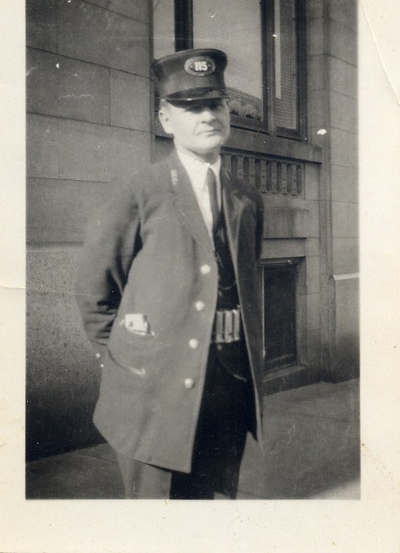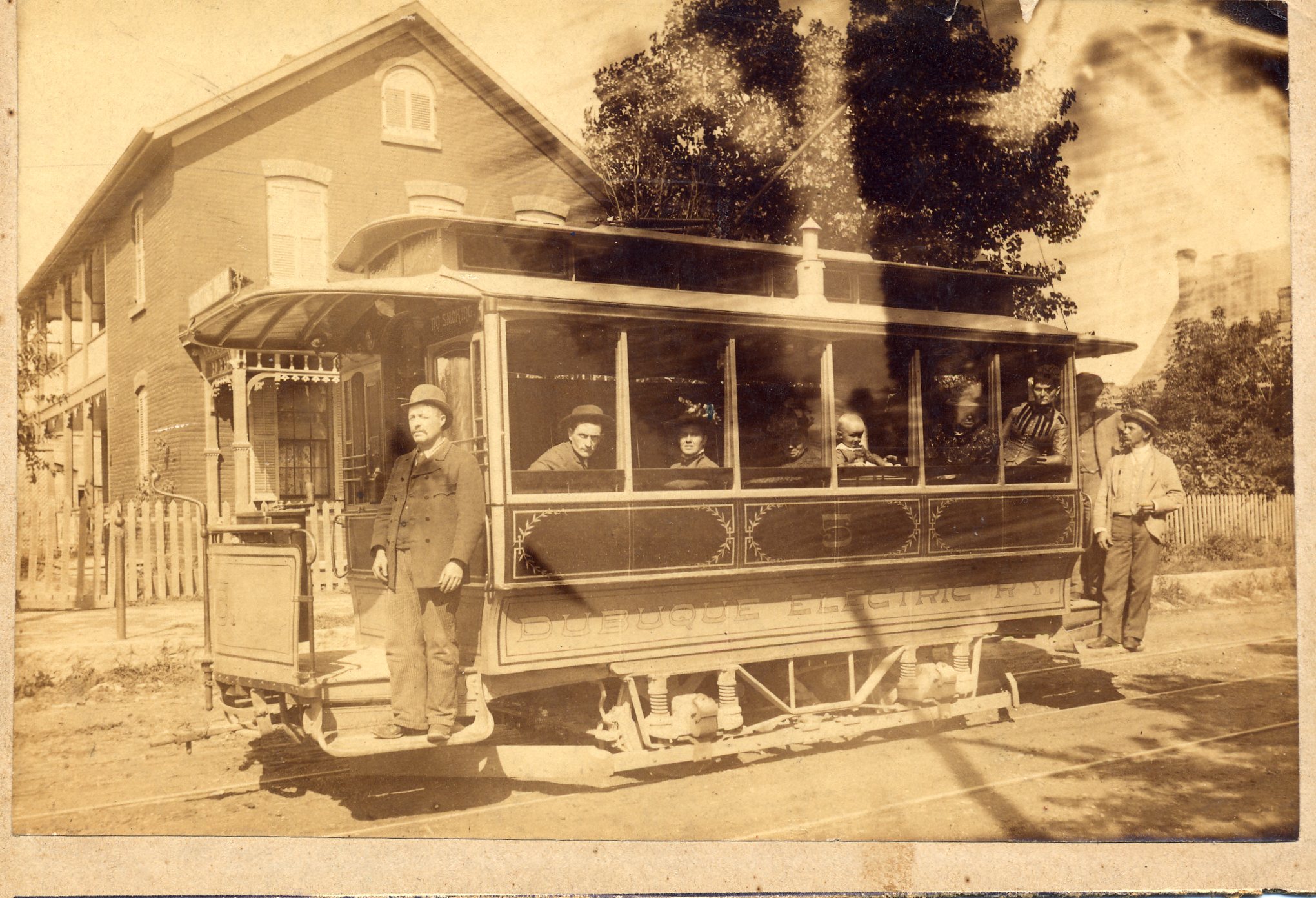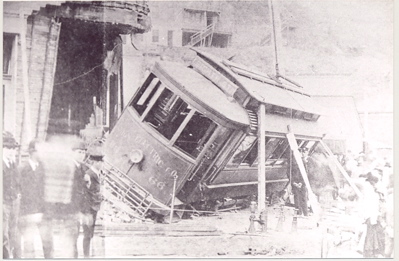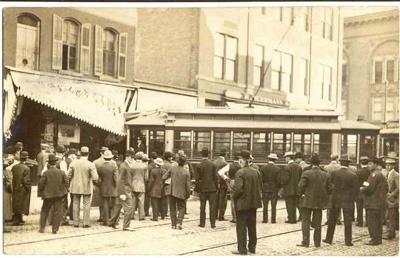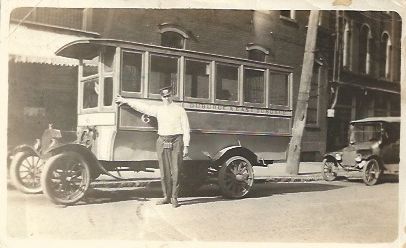Encyclopedia Dubuque
"Encyclopedia Dubuque is the online authority for all things Dubuque, written by the people who know the city best.”
Marshall Cohen—researcher and producer, CNN
Affiliated with the Local History Network of the State Historical Society of Iowa, and the Iowa Museum Association.
STREETCARS: Difference between revisions
No edit summary |
No edit summary |
||
| Line 1: | Line 1: | ||
[[Image:imp784.jpg|left|thumb|250px|Ready to make change or offer assistance, streetcar conductors like William A. Brown made the ride enjoyable. Photo courtesy: Bob Reding]][[Image:streetcars.jpg|right|thumb|350px|Dubuque Electric Railway.Photo courtesy: Bob Reding]]STREETCARS. On April 2, 1867, Dubuque citizens voted 2,188 to 137 to permit the use of streets for public transportation. (1) On | [[Image:imp784.jpg|left|thumb|250px|Ready to make change or offer assistance, streetcar conductors like William A. Brown made the ride enjoyable. Photo courtesy: Bob Reding]][[Image:streetcars.jpg|right|thumb|350px|Dubuque Electric Railway.Photo courtesy: Bob Reding]]STREETCARS. On April 2, 1867, Dubuque citizens voted 2,188 to 137 to permit the use of streets for public transportation. (1) On October 1, 1867 the [[DUBUQUE STREET RAILWAY COMPANY]] was organized by [[SMITH, Platt|Platt SMITH]], [[GRAVES, Julius K.|Julius K. GRAVES]], [[THOMPSON, John|John THOMPSON]], [[STOUT, Henry L.|Henry L. STOUT]], C. H. Merry, T. C. Roberts, and A. H. Gibbs. Julius K. Graves served as president with [[HEROD, Joseph|Joseph HEROD]] secretary and superintendent. At its October meeting, the city council adopted an ordinance establishing a right-of-way and imposed certain conditions and obligations on the company. By November 17th, a contract for constructing the line and supplying it with equipment was signed with Charles Hathaway of Philadelphia. (2) In 1868 the only other city west of the [[MISSISSIPPI RIVER]] to permit streetcars was St. Louis, Missouri. (3) | ||
On May 23, 1868, the horse-drawn trolley system using fifteen mules and horses and five cars each capable of carrying twenty passengers began operating. (4) The route of travel reached from the ferry landing at the foot of Jones Street, north on Main to 13th Street and on to 24th Street. One year later the line was extended to 32nd Street. In 1872 the company erected a large stable and car "house" at the northern end of Couler (Central) Avenue. | On May 23, 1868, the horse-drawn trolley system using fifteen mules and horses and five cars each capable of carrying twenty passengers began operating. (4) The route of travel reached from the ferry landing at the foot of Jones Street, north on Main to 13th Street and on to 24th Street. One year later the line was extended to 32nd Street. In 1872 the company erected a large stable and car "house" at the northern end of Couler (Central) Avenue. | ||
| Line 20: | Line 20: | ||
The total cost of the figures above ($5.51) was then compared to the estimated cost of running one two-horse car one day ($8.53). | The total cost of the figures above ($5.51) was then compared to the estimated cost of running one two-horse car one day ($8.53). | ||
The route began at 8th and Main, went up Hill Street to Third, up Third to Alpine, up Alpine to Julien Avenue and on Julien to Board for a ten-cent fare. (13) The company initially ordered two cars. One was an excursion car, "for the use of picnics and parties who desire to while away a few hours among the romantic woodlands that skirt | The route began at 8th and Main, went up Hill Street to Third, up Third to Alpine, up Alpine to Julien Avenue and on Julien to Board for a ten-cent fare. (13) The company initially ordered two cars. One was an excursion car, "for the use of picnics and parties who desire to while away a few hours among the romantic woodlands that skirt the western boundary of the city." (14) | ||
[[File:hills.jpeg|250px|thumb|left|(1890) Illustration of railway engine and car. Courtesy: Telegraph Herald]]In the first | [[File:hills.jpeg|250px|thumb|left|(1890) Illustration of railway engine and car. Courtesy: Telegraph Herald]]In the first month of operation, the railway claimed to have carried 30,000 passengers. (15) The railway was also linked to increased housing construction in the hill area. | ||
Poor service, primarily an inability to maintain a time schedule, led the City of Dubuque to threaten to revoke the company's franchise after seven years of operation. The equipment was dismantled and moved to Florida. The reputation of the company before it left led to its nickname, "Steam Dummy." (16) | Poor service, primarily an inability to maintain a time schedule, led the City of Dubuque to threaten to revoke the company's franchise after seven years of operation. The equipment was dismantled and moved to Florida. The reputation of the company before it left led to its nickname, "Steam Dummy." (16) | ||
| Line 30: | Line 30: | ||
The ordinance of March, 1889, granted permission and authority to David H. Ogden and his successors to construct, maintain and operate a single track electric street railway with all the necessary accessories on certain designated streets, prescribed the mode of operation and fixed the term at twenty years. (17) | The ordinance of March, 1889, granted permission and authority to David H. Ogden and his successors to construct, maintain and operate a single track electric street railway with all the necessary accessories on certain designated streets, prescribed the mode of operation and fixed the term at twenty years. (17) | ||
[[Image:dubuquelight.jpg|left|thumb|250px|Dubuque Light and Traction Company.Photo courtesy: Bob Reding]]The formation of the Key City Electric Street Railway Company signaled the arrival of electricity | [[Image:dubuquelight.jpg|left|thumb|250px|Dubuque Light and Traction Company.Photo courtesy: Bob Reding]]The formation of the Key City Electric Street Railway Company signaled the arrival of electricity. The Dubuque Street Railway, originally known as the Rhomberg Line, converted to electricity in 1890. A third competitor, the [[DUBUQUE ELECTRIC RAILWAY, LIGHT AND POWER COMPANY]], was started in 1889 by the Allen and Swiney Company. This company operated electric cars from Sixth and Iowa Streets to Jackson Street and the city limits. The Dubuque Electric Railway, Light and Power Company purchased the Key City Electric in 1893 and was reorganized as the [[DUBUQUE LIGHT AND TRACTION COMPANY]]. (18) | ||
Reorganization, acquisition and mergers flourished. A single trolley company, [[HOME ELECTRIC COMPANY]], emerged in 1899. The trolley system's car barn burned in 1901, one year before ownership of the trolley system was transferred to the Union Electric Company. In 1903 the bus barn at 24th and Central was constructed to replace the facilities destroyed in 1901. (19) | Reorganization, acquisition and mergers flourished. A single trolley company, [[HOME ELECTRIC COMPANY]], emerged in 1899. The trolley system's car barn burned in 1901, one year before ownership of the trolley system was transferred to the Union Electric Company. In 1903 the bus barn at 24th and Central was constructed to replace the facilities destroyed in 1901. (19) | ||
| Line 68: | Line 68: | ||
In April 1920 street car service had been halted for eight weeks. (21) Beginning in March, street car service stopped as the city and company officials argued over drivers and fares. The city would not repeal the ordinance prohibiting operation of one-man street cars nor would it permit the Dubuque Electric Company to raise fares. C. C. Mead, president of the union, did not blame the city council for the stalemate. (22) | In April 1920 street car service had been halted for eight weeks. (21) Beginning in March, street car service stopped as the city and company officials argued over drivers and fares. The city would not repeal the ordinance prohibiting operation of one-man street cars nor would it permit the Dubuque Electric Company to raise fares. C. C. Mead, president of the union, did not blame the city council for the stalemate. (22) | ||
With the reality of higher prices in the immediate future, pressure was brought on the company to limit a price hike. At issue was whether a hike in fares would result in enough income that a universal fare of five cents would be possible. (23) The answer was quick in coming. Fares were raised to twenty-five cents for four rides or seven cents for one ride. Those who had purchased the old 2.5 cent tickets could redeem them at the company offices. (24) | |||
Following a year of study, one-man streetcar operation was officially approved by the Dubuque City Council in 1920. This ruling, which eliminated the need for a motorman and conductor, applied to all streetcars except the one on the West Eighth line or Main Street during rush hours. (25) | |||
Following a year of study, one-man streetcar operation was officially approved by the Dubuque City Council in 1920. This ruling, which eliminated the need for a motorman and conductor, applied to all streetcars except the one on the West Eighth line or Main Street during rush hours. ( | |||
[[Image:bus2.jpg|left|thumb|200px|Transportation into East Dubuque. Photo courtesy: Bob Reding]] | [[Image:bus2.jpg|left|thumb|200px|Transportation into East Dubuque. Photo courtesy: Bob Reding]] | ||
| Line 79: | Line 77: | ||
In 1925 bus lines were started on an experimental basis. The idea was borrowed from the East Dubuque Electric Company that used eight buses to carry thirsty Dubuquers into Illinois when Iowa passed a [[PROHIBITION]] law. In 1929 the first street car line, Linwood, was replaced by buses. | In 1925 bus lines were started on an experimental basis. The idea was borrowed from the East Dubuque Electric Company that used eight buses to carry thirsty Dubuquers into Illinois when Iowa passed a [[PROHIBITION]] law. In 1929 the first street car line, Linwood, was replaced by buses. | ||
On May 11, 1931 the Dubuque City Council began the formal process of ending streetcar service in the city. A resolution was adopted authorizing [[INTERSTATE POWER COMPANY]] to abandon its single car track from 22nd Street north to 32nd Street on Central Avenue and to remove one of its double tracks on Central from 24th Street to 20th Street. ( | On May 11, 1931 the Dubuque City Council began the formal process of ending streetcar service in the city. A resolution was adopted authorizing [[INTERSTATE POWER COMPANY]] to abandon its single car track from 22nd Street north to 32nd Street on Central Avenue and to remove one of its double tracks on Central from 24th Street to 20th Street. (26) Interstate Power also petitioned to be given permission to abandon the entire Main Street car line, from Jones to 32nd Street and substitute buses for streetcars. This meant that the only remaining lines were West Locust, West Dubuque and Eagle Point which were expected to be closed in that order. (27) A. H. Smith, transportation superintendent for Interstate, stated that the company would substitute four buses for four street cars presently operated on Main Street with the same schedules being maintained. (28) The last streetcars ran on July 24, 1932. Bus service began the next day. In the years of their operation, streetcars were owned by fourteen different utilities. | ||
--- | --- | ||
| Line 129: | Line 127: | ||
22. "Two and a Half Cent Car Fare in Dubuque Ended by U. S Court Decision," ''Telegraph Herald'', August 21, 1919, p. 1 | 22. "Two and a Half Cent Car Fare in Dubuque Ended by U. S Court Decision," ''Telegraph Herald'', August 21, 1919, p. 1 | ||
23. " | 23. "25 Cent Rate to Be Exacted From Working People," ''Telegraph Herald'', August 23, 1919, | ||
24. | 24. Ibid. | ||
25. | 25. "One-Man Street Cars Approved," ''Telegraph Herald'', May 6, 1924, p. 8 | ||
26. " | 26. "Start Move to End Streetcar Service Here," ''Telegraph Herald'', May 12, 1931, p. 1 | ||
27. | 27. Ibid. | ||
28. Ibid. | 28. Ibid. | ||
[[Category: Transportation]] | [[Category: Transportation]] | ||
[[Category: Postcards]] | [[Category: Postcards]] | ||
Revision as of 21:35, 14 December 2014
STREETCARS. On April 2, 1867, Dubuque citizens voted 2,188 to 137 to permit the use of streets for public transportation. (1) On October 1, 1867 the DUBUQUE STREET RAILWAY COMPANY was organized by Platt SMITH, Julius K. GRAVES, John THOMPSON, Henry L. STOUT, C. H. Merry, T. C. Roberts, and A. H. Gibbs. Julius K. Graves served as president with Joseph HEROD secretary and superintendent. At its October meeting, the city council adopted an ordinance establishing a right-of-way and imposed certain conditions and obligations on the company. By November 17th, a contract for constructing the line and supplying it with equipment was signed with Charles Hathaway of Philadelphia. (2) In 1868 the only other city west of the MISSISSIPPI RIVER to permit streetcars was St. Louis, Missouri. (3)
On May 23, 1868, the horse-drawn trolley system using fifteen mules and horses and five cars each capable of carrying twenty passengers began operating. (4) The route of travel reached from the ferry landing at the foot of Jones Street, north on Main to 13th Street and on to 24th Street. One year later the line was extended to 32nd Street. In 1872 the company erected a large stable and car "house" at the northern end of Couler (Central) Avenue.
The fare on the horse-drawn street cars was ten cents. This remained in effect until a five-cent fare was started in 1875. (5)
Within months the company was leased to Platt SMITH and James Hughes with Joseph A. RHOMBERG as president. In 1876 Rhomberg, John J. LINEHAN, and Bart E. LINEHAN purchased the company. Rhomberg remained as president and the system became known as the Rhomberg Line.
The Rhomberg Line enjoyed a fine reputation with thirteen strong and well-kept cars, each capable of carrying twenty passengers. Cars passed each other every five minutes from dawn to late at night. A round trip took one hour. (6) To avoid cleaning snow from tracks in the winter, the company purchased sleighs. (7) In an effort to speed up the line, a system of storage battery cars were added, but with little success. (8) The total investment was estimated at $65,000 with annual income of $15,000. (9)
Beginning on July 12, 1877, a new firm, the HILL STREET AND WEST DUBUQUE STEAM RAILWAY COMPANY started by Julius K. Graves, attempted to haul passengers up the bluffs. At the suggestion of the Baldwin Locomotive Company of Philadelphia, Pennsylvania, miniature steam locomotives were used. Tests had previously been done on the engines in Philadelphia, Pennsylvania and Cincinnati, Ohio. (10) It was estimated that the use of the train would save three dollars daily in labor costs. (11) This was based on the following breakdown of costs for the steam engine: (12)
Total cost of fuel per day at 8 pounds per mile
at $4.00 per 2,240 pounds of anthracite coal $1.26
Oil, waste and tallow per day estimated .25
Engineer, 16 hours per day at .25 cents/hour 4.00
The total cost of the figures above ($5.51) was then compared to the estimated cost of running one two-horse car one day ($8.53).
The route began at 8th and Main, went up Hill Street to Third, up Third to Alpine, up Alpine to Julien Avenue and on Julien to Board for a ten-cent fare. (13) The company initially ordered two cars. One was an excursion car, "for the use of picnics and parties who desire to while away a few hours among the romantic woodlands that skirt the western boundary of the city." (14)
In the first month of operation, the railway claimed to have carried 30,000 passengers. (15) The railway was also linked to increased housing construction in the hill area.
Poor service, primarily an inability to maintain a time schedule, led the City of Dubuque to threaten to revoke the company's franchise after seven years of operation. The equipment was dismantled and moved to Florida. The reputation of the company before it left led to its nickname, "Steam Dummy." (16)
Steam-powered cable cars reached the top of the bluffs at Fourth Street after 1883 and at Eleventh Street after 1887. The ELEVENTH STREET ELEVATED RAILROAD operation was closed in 1927, but the FOURTH STREET ELEVATOR continued operation. Its power system after 1900 was supplied by electricity.
The ordinance of March, 1889, granted permission and authority to David H. Ogden and his successors to construct, maintain and operate a single track electric street railway with all the necessary accessories on certain designated streets, prescribed the mode of operation and fixed the term at twenty years. (17)
The formation of the Key City Electric Street Railway Company signaled the arrival of electricity. The Dubuque Street Railway, originally known as the Rhomberg Line, converted to electricity in 1890. A third competitor, the DUBUQUE ELECTRIC RAILWAY, LIGHT AND POWER COMPANY, was started in 1889 by the Allen and Swiney Company. This company operated electric cars from Sixth and Iowa Streets to Jackson Street and the city limits. The Dubuque Electric Railway, Light and Power Company purchased the Key City Electric in 1893 and was reorganized as the DUBUQUE LIGHT AND TRACTION COMPANY. (18)
Reorganization, acquisition and mergers flourished. A single trolley company, HOME ELECTRIC COMPANY, emerged in 1899. The trolley system's car barn burned in 1901, one year before ownership of the trolley system was transferred to the Union Electric Company. In 1903 the bus barn at 24th and Central was constructed to replace the facilities destroyed in 1901. (19)
Labor strife and disaster plagued the trolley system. The STREETCAR STRIKE OF 1903, Dubuque's first severe labor trouble, resulted in national notoriety for Union Electric as the Iowa State Militia was called out to restore order. (20) With the strike settled, the company remained in operation until 1916 when it was sold to the Dubuque Electric Company. Street car transportation reached its peak popularity at this time.
Brake failure on Easter, Sunday, April 23, 1905, caused a spectacular accident as a UNION ELECTRIC COMPANY car hurtled off its tracks and struck the unoccupied first floor of the Diamond House at Eighth Street and Julien (University) Avenue.
In the early 1900s service became more elaborate and popular. Eighty-five cars were placed into service with specialized summer cars that allowed breezes to blow on the riders. The ride became so popular that people were often only able to find seating at the end of the line. Some people walked in the opposite direction from which they wanted to go just to get a seat, while other riders jammed the aisles or hung on the roof. A popular trip of thirty-three minutes led to UNION PARK.
In April 1920 street car service had been halted for eight weeks. (21) Beginning in March, street car service stopped as the city and company officials argued over drivers and fares. The city would not repeal the ordinance prohibiting operation of one-man street cars nor would it permit the Dubuque Electric Company to raise fares. C. C. Mead, president of the union, did not blame the city council for the stalemate. (22)
With the reality of higher prices in the immediate future, pressure was brought on the company to limit a price hike. At issue was whether a hike in fares would result in enough income that a universal fare of five cents would be possible. (23) The answer was quick in coming. Fares were raised to twenty-five cents for four rides or seven cents for one ride. Those who had purchased the old 2.5 cent tickets could redeem them at the company offices. (24)
Following a year of study, one-man streetcar operation was officially approved by the Dubuque City Council in 1920. This ruling, which eliminated the need for a motorman and conductor, applied to all streetcars except the one on the West Eighth line or Main Street during rush hours. (25)
By 1924 Dubuque's electric system became the property of INTERSTATE POWER COMPANY. The increasing popularity of automobiles led Interstate to doubt the value of trolleys, and its fleet of streetcars was reduced from eighty-five to sixty.
In 1925 bus lines were started on an experimental basis. The idea was borrowed from the East Dubuque Electric Company that used eight buses to carry thirsty Dubuquers into Illinois when Iowa passed a PROHIBITION law. In 1929 the first street car line, Linwood, was replaced by buses.
On May 11, 1931 the Dubuque City Council began the formal process of ending streetcar service in the city. A resolution was adopted authorizing INTERSTATE POWER COMPANY to abandon its single car track from 22nd Street north to 32nd Street on Central Avenue and to remove one of its double tracks on Central from 24th Street to 20th Street. (26) Interstate Power also petitioned to be given permission to abandon the entire Main Street car line, from Jones to 32nd Street and substitute buses for streetcars. This meant that the only remaining lines were West Locust, West Dubuque and Eagle Point which were expected to be closed in that order. (27) A. H. Smith, transportation superintendent for Interstate, stated that the company would substitute four buses for four street cars presently operated on Main Street with the same schedules being maintained. (28) The last streetcars ran on July 24, 1932. Bus service began the next day. In the years of their operation, streetcars were owned by fourteen different utilities.
---
Source:
1. Duddleson, Irvin F. "From Horse Cars to Buses," Telegraph-Herald, October 3, 1943
2. "Dubuque County Before 1880," Telegraph Herald, October 16, 1933, p. 9
3. Duddleson, Irvin F.
4. "Dubuque County..."
5. Duddleson, Irvin F.
6. "Dubuque County..."
7. McCormick, John. "Transit Transition," Telegraph Herald, August 28, 1973, p. 13
8. Duddleson, Irvin F.
9. "Dubuque County..."
10. "All Aboard for the Bluffs," Dubuque Herald, May 27, 1877 (no pages given)
11. Ibid.
12. Ibid.
13. "All Aboard for the Bluffs,"
14. "Caught on the Fly," Dubuque Herald, September 1, 1877 (no pages given)
15. McCormick, John.
16. Ibid.
17. Dubuque Folklore. American Trust and Savings Bank. 1976
18. McCormick, John.
19. Ibid.
20. "Street Cars Pass From Public Mind," Telegraph Herald, April 18, 1920, p. 15
21. "Council Refuses Merchants' Plea for One Man Car," Telegraph Herald, April 1, 1920, p. 1
22. "Two and a Half Cent Car Fare in Dubuque Ended by U. S Court Decision," Telegraph Herald, August 21, 1919, p. 1
23. "25 Cent Rate to Be Exacted From Working People," Telegraph Herald, August 23, 1919,
24. Ibid.
25. "One-Man Street Cars Approved," Telegraph Herald, May 6, 1924, p. 8
26. "Start Move to End Streetcar Service Here," Telegraph Herald, May 12, 1931, p. 1
27. Ibid.
28. Ibid.


